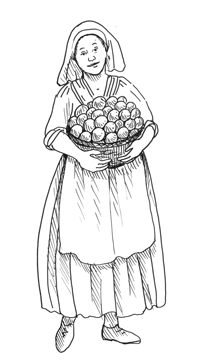STRANGE BUT TRUE- Orangemen: Theater-goers of yore had healthy snacks

DRAWING BY DEBORAH DERR McCLINTOCK
Q. If you took a concession break at the cinema or theater and found not popcorn and candy but oranges to buy, where would you be? –H. Lattimore
A. It's not so much a matter of where but when, since up until the end of the 19th century in Europe, oranges were a symbol of affluence and good times, accompanying festive occasions, says Pierre Laszlo in Citrus: A History.
Served at weddings and banquets, oranges were also offered at the theater. During the Renaissance, specialized
peddlers called orange-men and orange-women would roam the streets of large cities like London, Paris, and Amsterdam carrying baskets filled with the fruit. In Palermo, Sicily, they advertised their wares with the strange cry, "Here's the honey!" and in Cairo, "Honey! Oh, oranges! Honey!"
Up until World War I, theaters were also places for oranges. Here were "the predecessors of the vendors now selling popcorn and candy at the entrance of American movie theaters or hot dogs and chips at stadiums."
Q. A hockey puck a) can cost up to $50,000 b) was once fashioned out of a lacrosse ball c) is refrigerated for National Hockey League games d) is made of vulcanized rubber, the same stuff as auto tires, shoe soles, etc. –J. Frost
A. All are true, as hockey was originally played with a lacrosse ball until exasperated rink owners got tired of all the broken windows from errant orbs, says Alain Hache in The Physics of Hockey. So they cut the ball into three pieces and kept the puckish middle section.
"Ever since 1885, the game has been played with just such a rubber slice," Hache says.
Rubber, of course, is one of the most elastic materials on Earth, and even vulcanization– a process discovered by American inventor Charles Goodyear in 1839– doesn't stop pucks from bouncing. In fact, they bounce too much, the reason for the refrigeration; a cold puck will bounce to only about half the height of a warm one. Unfortunately, this creates a new problem: a hard frozen puck traveling at 90 mph is a dangerous projectile!
As to the $50,000 puck, the Fox TV network once engineered a high-tech NHL version with a superimposed blue comet-like TV trailer that turned red on screen at speeds beyond 70 mph. But hard-core fans were not thrilled– nor were the players, who claimed the puck's screws skewed its sliding. The idea was dropped.
Q. A doctor tells you you have eight months to live. How might understanding the nature of mathematical "mean" or "median" breathe new hope into you, and– if you're very lucky– point the way to 20 more years of life for you? –E.K. Ross
A. This happened to Harvard paleontologist and author Stephen Jay Gould, who after being diagnosed with a rare abdominal cancer in 1982, learned that the median survival time was only eight months, say Michael Blastland and Andrew Dilnot in The Tiger That Isn't: Seeing Through a World of Numbers. Gould was stunned.
Yet within about 15 minutes, he started analyzing: the median is the point where half of the numbers are above and half are below, meaning that half the people so diagnosed would be dead within eight months but half would live longer than eight months. Since his condition was caught early, he felt he had good reason to believe he'd be in the upper half. Moreover, since the statistical "tail" of the longevity distribution extended out several years beyond the eight-month median, he had a chance of living well beyond the eight months.
This understanding allowed Gould to breathe a sigh of relief and to feel he had time left to plan, to fight, to live. "He lived not eight months, but another 20 years, and when he did die, in 2002, it was of an unrelated cancer," Dilnot writes.
Q. On a plane, do you or the stranger seated next to you take command of the common armrest? Are you a guy? –C. Lindberg
A. This falls in the psychological category of proxemics, or maintenance of "personal space" as a kind of portable buffer zone to keep others from getting too close.
But how close is too close? Typically, powerful, high-status people seem to "own" and control more space, says Richard Lippa in Introduction to Social Psychology. And since men traditionally possess more power than women in most societies, they may show this by taking up more space.
Thus both men and women tend to give male pedestrians a wider berth on a sidewalk (potential aggression is another factor). In a plane, this translates into 3-to-1 odds that as between a woman and a man, the man will commandeer the armrest– a ratio that holds even after taking into account men's larger average body size.
Send Strange questions to brothers Bill and Rich at [email protected].